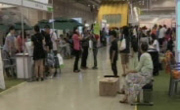슴베찌르개는 대전 용산동 구석기유적에서 가장 대표적인 석기로 2,200여 점의 석기 가운데 38점이 분류되었으며 연모의 대부분을 차지하고 있다. 이 글에서는 용산동구석기유적에서 출토된 ...
http://chineseinput.net/에서 pinyin(병음)방식으로 중국어를 변환할 수 있습니다.
변환된 중국어를 복사하여 사용하시면 됩니다.
- 中文 을 입력하시려면 zhongwen을 입력하시고 space를누르시면됩니다.
- 北京 을 입력하시려면 beijing을 입력하시고 space를 누르시면 됩니다.

대전 용산동 구석기유적 출토 슴베찌르개의 성격 = The Characteristic of Tanged Points from Yongsan-dong Palaeolithic site, Daejeon, Korea
한글로보기https://www.riss.kr/link?id=A101135730
- 저자
- 발행기관
- 학술지명
- 권호사항
-
발행연도
2006
-
작성언어
-
- 주제어
-
KDC
911
-
등재정보
KCI등재
-
자료형태
학술저널
-
수록면
1-22(22쪽)
-
비고
학회 요청에 의해 무료로 제공
- 제공처
-
0
상세조회 -
0
다운로드
부가정보
국문 초록 (Abstract)
1점의 석영암 슴베 조각을 제외한 나머지 슴베찌르개는 모두 혼펠스 돌날로 제작되었다.
길이에 따라서는 두 개의 그룹으로 구분되어 기능의 분화 가능성을 생각해 볼 수 있으며, 슴베의 아래끝부분 너비도 뾰족한 형태와 넓은 것으로 구분되어 자루의 장착방법에 차이가 있었을 것으로 생각된다. 위끝부분의 각도는 중간각으로 이루어져 있다.
슴베찌르개의 도구축과 돌날격지의 타격축은 서로 반대방향을 이루는 것이 관찰되며, 돌날의 상태에 따라 두터운 부분을 슴베로 제작하였음을 알 수 있다. 슴베는 가파른 잔손질을 통하여 직선 또는 오목한 형태로 만들었으며, 1점만이 확인되었지만 슴베의 양쪽이 모두 흠날모양으로 제작된 것이 있어 독특한 형태로 주목된다. 위끝부분의 잔손질은 대부분 한쪽 가장자리에 가파른 각도로 이루어졌으며, 잔손질된 반대편 가장자리는 날카로운 자연날을 그대로 이용하였다.
대부분 완형의 슴베찌르개가 출토되는 다른 유적들과는 달리 용산동 구석기유적에서는 위끝·중간 또는 슴베부분 등이 절단된 상태로 출토된 것이 약 80%에 이른다. 슴베부분이 절단된 것이 가장 많이 나타나며, 단면은 연모 방향과 직각을 이루는 것이 대부분이다, 절단면의 특징으로 보아 제작과정보다는 연모의 사용 후 자루에서 해체하지 않고 유적으로 돌아왔음을 유추할 수 있으며, 용산동 구석기유적이 base camp로서의 기능을 가지고 있음을 알 수 있다.
슴베찌르개에서 나타나는 이러한 특징들은 절대연대측정값과 함께 유적을 이해하는 데에 있어 좋은 자료로 평가되며, 앞으로 슴베찌르개의 제작 및 사용실험이 충분히 이루어지면 좀더 구체적인 양상을 파악할 수 있을 것으로 기대한다.
슴베찌르개는 대전 용산동 구석기유적에서 가장 대표적인 석기로 2,200여 점의 석기 가운데 38점이 분류되었으며 연모의 대부분을 차지하고 있다. 이 글에서는 용산동구석기유적에서 출토된 슴베찌르개를 대상으로 하여 암질과 몸체의 선택, 크기에서 보이는 특정과 제작수법 깨진 상태 등의 속성에서 나타나는 특징을 살펴본 후, 이를 통하여 유적의 성격을 유추하여 보고자 하였다.
1점의 석영암 슴베 조각을 제외한 나머지 슴베찌르개는 모두 혼펠스 돌날로 제작되었다.
길이에 따라서는 두 개의 그룹으로 구분되어 기능의 분화 가능성을 생각해 볼 수 있으며, 슴베의 아래끝부분 너비도 뾰족한 형태와 넓은 것으로 구분되어 자루의 장착방법에 차이가 있었을 것으로 생각된다. 위끝부분의 각도는 중간각으로 이루어져 있다.
슴베찌르개의 도구축과 돌날격지의 타격축은 서로 반대방향을 이루는 것이 관찰되며, 돌날의 상태에 따라 두터운 부분을 슴베로 제작하였음을 알 수 있다. 슴베는 가파른 잔손질을 통하여 직선 또는 오목한 형태로 만들었으며, 1점만이 확인되었지만 슴베의 양쪽이 모두 흠날모양으로 제작된 것이 있어 독특한 형태로 주목된다. 위끝부분의 잔손질은 대부분 한쪽 가장자리에 가파른 각도로 이루어졌으며, 잔손질된 반대편 가장자리는 날카로운 자연날을 그대로 이용하였다.
대부분 완형의 슴베찌르개가 출토되는 다른 유적들과는 달리 용산동 구석기유적에서는 위끝·중간 또는 슴베부분 등이 절단된 상태로 출토된 것이 약 80%에 이른다. 슴베부분이 절단된 것이 가장 많이 나타나며, 단면은 연모 방향과 직각을 이루는 것이 대부분이다, 절단면의 특징으로 보아 제작과정보다는 연모의 사용 후 자루에서 해체하지 않고 유적으로 돌아왔음을 유추할 수 있으며, 용산동 구석기유적이 base camp로서의 기능을 가지고 있음을 알 수 있다.
슴베찌르개에서 나타나는 이러한 특징들은 절대연대측정값과 함께 유적을 이해하는 데에 있어 좋은 자료로 평가되며, 앞으로 슴베찌르개의 제작 및 사용실험이 충분히 이루어지면 좀더 구체적인 양상을 파악할 수 있을 것으로 기대한다.
다국어 초록 (Multilingual Abstract)
The tanged points from Yongsan-dong Palaeolithic site which were most representative tools, classified thirty-eight pieces, are composed of the most part of tools.
This paper studied character of raw material, technique and broken condition through tanged points from Yongsan-dong Palaeolithic site, and guessed specific character of the site.
Except for one quarzite tang, the rest of the tanged points were made of homfels. They were divided into two groups in accordance with the length, so we can think about possibility of the functional specialization.
It is observed that morphological and debitage axis make the opposite direction.
The proximal part and the breadth of tanged points were divided into the pointed and broad type, so we can guess there are differences of the method to attach to the shafts.
According to the condition of blade, the tang was made of thick part of blade. The tang was formed into straight or concave type. Although only one item was excavated, it is unique that both side of tang was formed of notch shape.
Most retouch of the distal part was made of blunt angle on the single edge. The oppsite edge of retouch used sharp natural edge as it is.
Tanged points from Yongsan-dong Palaeolithic site which was excavated almost reached 80% as distal end, mesial part or haft was broken. The most of them was excavated as haft was broken. The cross section meet tool direction at right angles.
It is analogized through aspects of cross section that the tanged points came back to the site after using as not dismantled from shafts. According to these aspects, we know Yongsan-dong Palaeolithic site proves the function of base camp.
This character of tanged points are estimated good evidences with 14C age to understand the site. From now on, enough experiments of producing and using tanged points will provide us more specific information.
Yongsan-dong palaeolithic site is located near the Geum river basin and it was excavated twice between 2003 and 2005. Artifacts originating in one cultural layer of the upper paleolithic age is formed earlier than soil-wedge structure and shows compar...
Yongsan-dong palaeolithic site is located near the Geum river basin and it was excavated twice between 2003 and 2005. Artifacts originating in one cultural layer of the upper paleolithic age is formed earlier than soil-wedge structure and shows comparatively stable space distribution aspect. Stone artifacts are mostly consisted of quartzite and homfels, and other kinds are rarely seen. Excavated artifacts are core, flake, blade, debris, pebble and tool, and tool included tanged point, scraper, awl, chopping-tool, polyhedron and so on.
The tanged points from Yongsan-dong Palaeolithic site which were most representative tools, classified thirty-eight pieces, are composed of the most part of tools.
This paper studied character of raw material, technique and broken condition through tanged points from Yongsan-dong Palaeolithic site, and guessed specific character of the site.
Except for one quarzite tang, the rest of the tanged points were made of homfels. They were divided into two groups in accordance with the length, so we can think about possibility of the functional specialization.
It is observed that morphological and debitage axis make the opposite direction.
The proximal part and the breadth of tanged points were divided into the pointed and broad type, so we can guess there are differences of the method to attach to the shafts.
According to the condition of blade, the tang was made of thick part of blade. The tang was formed into straight or concave type. Although only one item was excavated, it is unique that both side of tang was formed of notch shape.
Most retouch of the distal part was made of blunt angle on the single edge. The oppsite edge of retouch used sharp natural edge as it is.
Tanged points from Yongsan-dong Palaeolithic site which was excavated almost reached 80% as distal end, mesial part or haft was broken. The most of them was excavated as haft was broken. The cross section meet tool direction at right angles.
It is analogized through aspects of cross section that the tanged points came back to the site after using as not dismantled from shafts. According to these aspects, we know Yongsan-dong Palaeolithic site proves the function of base camp.
This character of tanged points are estimated good evidences with 14C age to understand the site. From now on, enough experiments of producing and using tanged points will provide us more specific information.
목차 (Table of Contents)
- 요약
- I. 머리말
- II. 용산동 구석기유적의 개관
- III. 슴베찌르개의 분석
- IV. 맺음말
- 요약
- I. 머리말
- II. 용산동 구석기유적의 개관
- III. 슴베찌르개의 분석
- IV. 맺음말
- 참고문헌
- Abstract
동일학술지(권/호) 다른 논문
-
- 중앙문화재연구원
- 李鉉祐
- 2006
- KCI등재
-
- 중앙문화재연구원
- 申年植
- 2006
- KCI등재
-
- 중앙문화재연구원
- 도문선(Do Moon sun)(都文善)
- 2006
- KCI등재
-
- 중앙문화재연구원
- 오재진(Oh Jae jin)(吳在鎭)
- 2006
- KCI등재




 스콜라
스콜라






